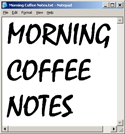
|
|||||||||||||||||||||||||||||||||||||||||||||||||||||||||||||
|
Office and conference FlickrFans I don't have an office, and I'm not running a conference, so I hope to hook up with someone, hopefully in the Bay Area, with either of these, to try some experimentation with FlickrFan. First a little background... My first glimpse of how wonderful news photography and screen savers are together was when I visited Andy Rhinehart at the Spartanburg Herald-Journal on 2/15/05. He had to go to a meeting, and left me in his office to check email, update my blog using my laptop. HIs PC of course went into screen saver mode, and started showing pictures of various political leaders in meetings around the world and sporting events, people digging out of snow storms. It didn't take long before my eyes were fixed on his screen. Later I found out that everyone at AP does this too. If you have a folder of new pictures on your LAN it makes a fantastic source of distraction. But it's different from video because it's silent. You can have a conversation about what's on the screen without interfering with it, or try to have a conversation about something else entirely. This is something we noticed about podcasting too, that sometimes less is more. Because there is no video you can: 1. Use your eyes for something else, like driving, walking, doing housework. 2. Use your imagination in ways you can't with video, imagine what the speakers look like, where they are, who else is there. Once your imagination is activated in one direction it goes off in others. So photocasting or picturecatching, whatever it ends up being called, has a similar "less is more" dimension. So then I tried an experiment, I put an early version of FlickrFan on a 46-inch screen in my den, and when people would come over to visit I'd leave it running and we'd talk about whatever we were going to talk about, and I wasn't surprised to see the attention drift over to the TV. It's captivating. So I'd like to try it in two new venues to see what happens. 1. In a reception area in an office. Imagine one of the buildings at Microsoft. Or a doctors office, or the lobby of a VC firm. Install a big flatscreen TV on the wall, with a Mac Mini behind it, with a net connection, and let it run. See if people don't gravitate to it. See if people don't want to have meetings in the lobby. (I think some might.) 2. At a conference, like Demo or Davos, scatter four screens around the main lobby (not the meeting room), with one Mac driving them all or each with its own Mac Mini. Again see how it affects the dynamic. You might want to show pictures taken at the conference for a unique recursive effect. Or just use the AP news photo feed. Either would be sufficient to learn how it works. I bet we would learn a lot. Let me know if you decide to give it a try, and by all means please blog about your experiences, share what you learn with the rest of us. Apparently Photobucket supports RSS (good). They use media-rss (also good). But they seem to only provide thumbnails of the photos, which is not good (if true). Here's the RSS feed for my newly created Photobucket account. Update: James Holderness says a link to the full-size image is there. |
Dave Winer, 52, pioneered the development of weblogs, syndication (RSS), podcasting, outlining, and web content management software; former contributing editor at Wired Magazine, research fellow at Harvard Law School, entrepreneur, and investor in web media companies. A native New Yorker, he received a Master's in Computer Science from the University of Wisconsin, a Bachelor's in Mathematics from Tulane University and currently lives in Berkeley, California. "The protoblogger." - NY Times.
"The father of modern-day content distribution." - PC World.
One of BusinessWeek's 25 Most Influential People on the Web. "Helped popularize blogging, podcasting and RSS." - Time.
"The father of blogging and RSS." - BBC.
"RSS was born in 1997 out of the confluence of Dave Winer's 'Really Simple Syndication' technology, used to push out blog updates, and Netscape's 'Rich Site Summary', which allowed users to create custom Netscape home pages with regularly updated data flows." - Tim O'Reilly.
My most recent trivia on Twitter. On This Day In: 2006 2005 2004 2003 2002 2001 2000 1999 1998 1997.
|
||||||||||||||||||||||||||||||||||||||||||||||||||||||||||||
|
© Copyright 1997-2007 Dave Winer. Previous / Next |
|||||||||||||||||||||||||||||||||||||||||||||||||||||||||||||


